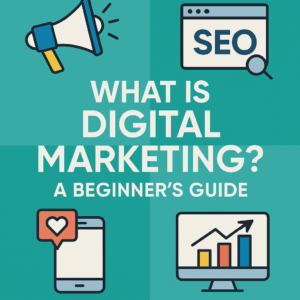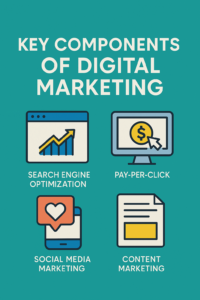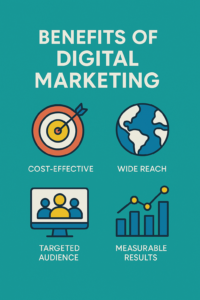
Digital marketing has become a cornerstone of business growth in today’s internet-driven world. Whether you’re a business owner, aspiring marketer, or simply curious about this dynamic field, understanding digital marketing is essential. This guide delves into what digital marketing is, its key components, benefits, and how you can start implementing it.
What is Digital Marketing?
Digital marketing refers to the use of online platforms and digital technologies to promote products, services, or brands. Unlike traditional marketing, which relies on mediums like print, TV, and radio, digital marketing leverages the internet and electronic devices to reach and engage audiences. The goal is to connect with potential customers in the digital spaces they frequent, such as websites, social media, and search engines.
Key examples of digital marketing include search engine optimization (SEO), social media marketing, email marketing, pay-per-click (PPC) advertising, and content marketing. These strategies can work individually or in tandem to achieve specific marketing objectives.

Key Components of Digital Marketing:
1. Search Engine Optimization (SEO)
SEO is the process of optimizing your website to rank higher on search engine results pages (SERPs). A well-executed SEO strategy can increase organic traffic and visibility. Key aspects of SEO include:
- Keyword Research: Identifying the terms your audience is searching for.
- On-Page Optimization: Enhancing website content, meta tags, and headers.
- Technical SEO: Improving site speed, mobile-friendliness, and navigation.
Example: If you run a furniture store, targeting keywords like “modern sofa designs” can drive relevant traffic.
2. Content Marketing
Content marketing focuses on creating and sharing valuable content to attract and retain customers. It includes blog posts, videos, infographics, and eBooks. Quality content helps build trust and authority in your niche.
Internal Link Suggestion: Learn more about creating engaging content.
3. Social Media Marketing
Social media platforms like Facebook, Instagram, LinkedIn, and Twitter are excellent for building brand awareness and engaging with your audience. Social media marketing involves:
- Creating compelling posts and stories.
- Running paid ad campaigns.
- Interacting with followers to build relationships.
4. Pay-Per-Click Advertising (PPC)
PPC is a paid marketing method where advertisers pay a fee each time their ad is clicked. Google Ads and Facebook Ads are popular PPC platforms. This strategy ensures immediate visibility and drives traffic.
External Link Suggestion: Check out Google Ads’ official guide.
5. Email Marketing
Email marketing involves sending personalized messages to your audience to nurture leads and drive sales. Examples include newsletters, product promotions, and customer onboarding emails. Tools like Mailchimp make it easy to manage email campaigns.
6. Analytics and Reporting
Measuring the performance of digital marketing efforts is crucial. Tools like Google Analytics and SEMrush provide insights into traffic, engagement, and conversions, helping marketers refine their strategies.

Benefits of Digital Marketing
1. Global Reach
Digital marketing allows businesses to reach a global audience without the geographic limitations of traditional marketing.
2. Cost-Effectiveness
Many digital marketing strategies, like SEO and social media, offer a high return on investment (ROI) compared to traditional advertising methods.
3. Targeted Advertising
Digital platforms enable precise targeting based on demographics, interests, and behavior. For example, Facebook Ads allow you to target users by age, location, and even purchase intent.
4. Measurable Results
Unlike traditional campaigns, digital marketing provides real-time data. Marketers can track impressions, clicks, and conversions, making it easier to gauge success.
5. Engagement and Interaction Digital marketing facilitates direct interaction with your audience through comments, reviews, and messages, fostering better customer relationships.

How to Get Started with Digital Marketing
1. Define Your Goals
Determine what you want to achieve. Common goals include increasing website traffic, generating leads, or boosting brand awareness.
2. Identify Your Target Audience
Understand your audience’s needs, preferences, and online behavior. This information helps tailor your strategies effectively.
3. Choose the Right Channels
Select platforms that align with your audience’s preferences. For example, a B2B company might focus on LinkedIn, while a B2C brand may prioritize Instagram.
4. Create a Content Plan
Develop a content calendar that outlines the type of content you’ll create, publish dates, and promotion strategies.
5. Monitor and Optimize Regularly track your campaigns’ performance and adjust strategies as needed. Use analytics tools to gain insights and refine your approach.
Conclusion
Digital marketing is a powerful tool for businesses and individuals alike. It offers unparalleled opportunities to connect with audiences, build brands, and achieve goals. By understanding its key components and implementing effective strategies, you can harness the potential of digital marketing to grow and succeed.
Whether you’re starting your digital marketing journey or looking to refine your approach, remember that continuous learning and adaptation are essential. Begin with small, focused campaigns, and scale as you gain experience and confidence.
Monitor and Optimize: It is crucial to monitor the performance of your digital marketing efforts regularly and optimize them to improve results. By analyzing data and making necessary adjustments, you can ensure that your strategies are effective and efficient. Remember, the digital landscape is constantly evolving, so staying proactive and agile is key to sustained success.
